You’ve seen them in movies, and perhaps you’ve wondered yourself: how effective are military gas masks? In a world where preparedness is key, understanding the capabilities and limitations of these protective devices is essential.
Military gas masks provide reliable protection against a range of threats, from chemical and biological agents to radiological and nuclear hazards. Their advanced filtration systems and airtight seals ensure your safety in critical situations, making them a vital addition to your preparedness gear.
But the effectiveness of military gas masks goes beyond their role as a protective shield. In this article, we’ll explore maintenance and lifespan, practical usage and training, advanced models and their features, legal considerations, and safety tips.
How Military Gas Masks Work
When you think about military gas masks, the first question that might come to mind is how they actually work. These masks are more than just a covering; they are sophisticated devices designed to protect you in extreme conditions.
Let’s delve into the technology behind these masks and see how they stack up against their civilian counterparts. But first, here’s a video demonstration you can watch:
Military gas masks are engineered with advanced filtration technology to provide you with the utmost protection. At their core, these masks use a combination of physical and chemical filtration.
Physical filtration blocks particles like dust and debris, while chemical filtration uses activated carbon and other substances to neutralize harmful chemicals and gasses. This dual approach ensures that you’re safeguarded against a wide range of airborne threats, from smoke and particulates to toxic gasses.
Another key aspect of these masks is the air purification system. Unlike simple masks, military gas masks have complex systems that not only filter but also actively purify the air you breathe. This system is crucial in environments where the air is heavily contaminated with harmful agents, providing you with clean, breathable air even in the most hostile conditions.
Comparing Military and Civilian Gas Masks: Standards and Capabilities
Now, you might wonder how military gas masks differ from the ones civilians use. The primary difference lies in the standards and capabilities. Military gas masks are designed to meet stringent military specifications, ensuring they can withstand extreme conditions and provide broader protective capabilities compared to civilian models.
For instance, military gas masks are tested to protect against a wider range of chemical and biological agents. They also often include additional features like voice diaphragms for communication and robust visors for better visibility.
In contrast, civilian masks might not offer the same level of comprehensive protection, being more focused on specific threats like industrial chemicals or pollution.
Below is a more in-depth comparison between military gas masks and civilian gas masks:
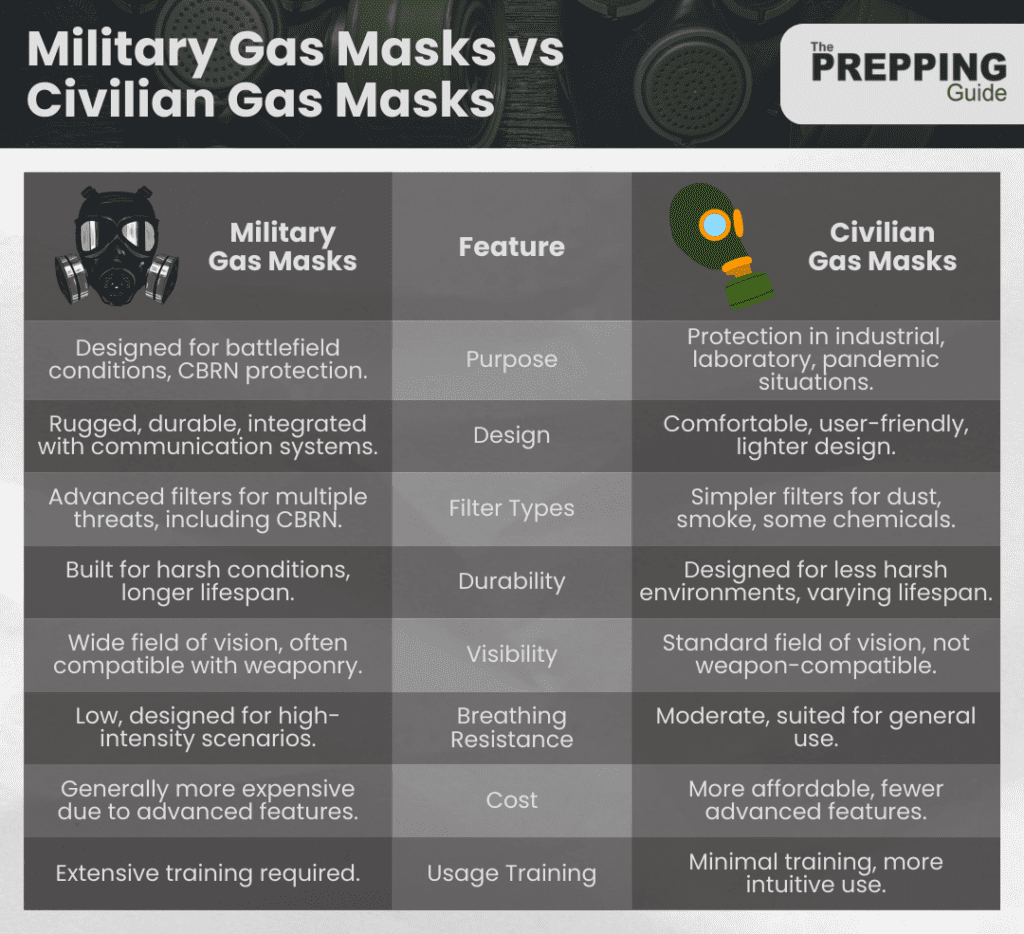
Military Gas Masks vs. N95
Military gas masks and N95 respirators serve different purposes, and understanding these differences is key to choosing the right protection. N95 masks are designed primarily for filtering out particulate matter. They are effective in environments where you need protection against dust, smoke, or certain pathogens. However, N95 masks do not offer protection against chemicals or gasses.
In contrast, military gas masks provide comprehensive protection against a broader range of threats, including chemicals, gasses, and particulates. Their robust design and advanced filtration system make them suitable for more hazardous environments where N95 masks would be inadequate. While N95 masks are great for certain scenarios like disease outbreaks or pollution, military gas masks are the go-to option for scenarios involving chemical or biological threats.
Effectiveness Against Various Threats
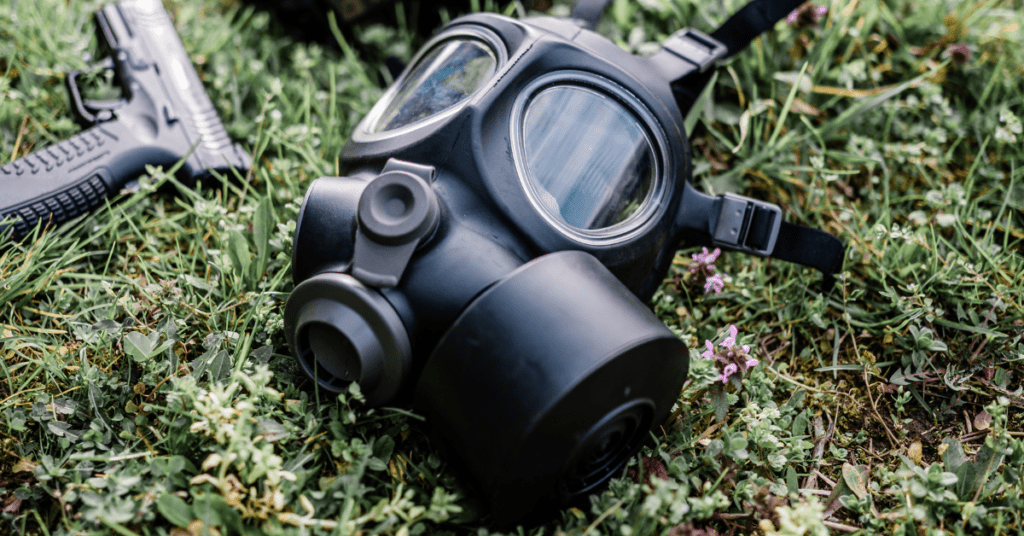
Military gas masks are your first line of defense against a range of hazardous agents. They are designed to protect you from chemical agents like nerve and blister agents, biological threats such as bacteria and viruses, and even radioactive particles. This level of protection is achieved through a combination of advanced filtration technology and robust sealing, ensuring that harmful agents don’t penetrate the mask.
Chemical agents, for instance, are neutralized by the mask’s filtration system, preventing them from causing harm. Similarly, biological agents are filtered out, keeping you safe from potential biological warfare or natural outbreaks. Even in the presence of radioactive dust or particles, these masks can offer a significant level of protection, making them an indispensable tool in your safety arsenal.
While military gas masks offer extensive protection, it’s important to be aware of their limitations.
No protective gear is foolproof, and understanding these constraints helps you make informed decisions. For example, these masks are not designed for use underwater or in environments with very low oxygen levels.
In underwater scenarios, the filtration system of a gas mask is rendered ineffective due to the water barrier. Similarly, in low oxygen environments, the masks cannot supply oxygen; they can only filter existing air.
Therefore, it’s crucial to assess the environment you’re preparing for and understand that while military gas masks are highly effective in many scenarios, they have specific limitations that must be considered.
When to Choose Military Gas Masks Over Other Protective Gear
Choosing the right protective gear depends on the specific threats you’re preparing for. In scenarios where you’re likely to encounter chemical or biological threats, or where you need robust protection for your entire face, a military gas mask is the superior choice. These masks offer comprehensive coverage, protecting not just your respiratory system but also your eyes and face from harmful agents.
It’s also worth considering a military gas mask if you need durable, long-lasting protective gear. Their design and materials are built to withstand harsh conditions and extended use. On the other hand, for everyday scenarios like air pollution or during a pandemic, simpler masks like N95 respirators or cloth masks might suffice. In essence, military gas masks are ideal for more severe, hazardous conditions where maximum protection is paramount.
Design and Technology of Military Gas Masks
Design and technology are tailored to ensure the highest level of protection in some of the most hazardous environments. This article delves into the intricate design and sophisticated technology that underpin these essential defense tools.
Materials and Construction
Military gas masks are constructed from durable materials designed to withstand extreme conditions. Typically, these materials include silicone rubber for the facepiece, offering flexibility and a snug fit, and polycarbonate for the visor, ensuring clarity and resistance to impact. The robust construction not only provides protection against toxic agents but also ensures a longer lifespan of the mask under harsh conditions.
Advanced Filtration Systems
At the heart of a military gas mask’s effectiveness is its filtration system. These systems are designed to protect against a wide array of threats, including chemical, biological, radiological, and nuclear (CBRN) agents. The filters are usually a combination of activated carbon and other sorbents, capturing harmful particles and gases. This multi-layered approach ensures comprehensive protection, crucial for soldiers in diverse threat environments.
Sealing and Fit
A critical aspect of the gas mask’s design is its ability to seal effectively against the face. An improper seal can compromise the mask’s integrity, allowing hazardous substances to penetrate. Therefore, military gas masks are designed with adjustable straps and ergonomic features to fit various face shapes securely. Some models also include a drinking tube system, allowing hydration without compromising the seal.
Integrated Communication Systems
Modern military gas masks often incorporate communication systems. These systems are designed to function seamlessly with the mask, ensuring clear communication even in contaminated environments. Such integration is crucial for coordinated operations where communication can mean the difference between life and death.
Enhanced Visibility and Durability
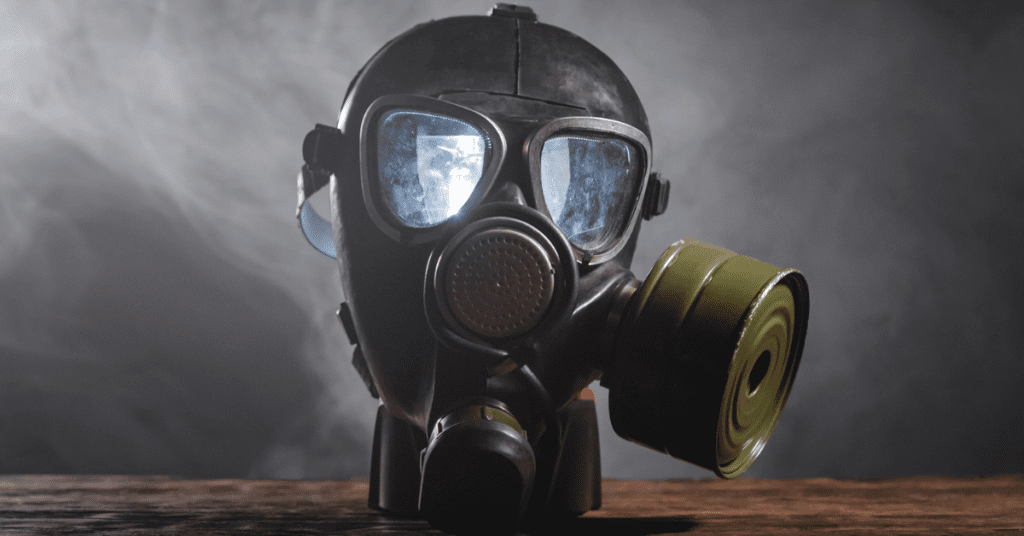
The visor of a military gas mask is designed for maximum visibility and minimal distortion. This is crucial for maintaining situational awareness on the battlefield. Additionally, the materials used are resistant to scratching and fogging, further enhancing visibility under diverse conditions.
Challenges and Limitations of Military Gas Masks
Military gas masks are essential for soldiers’ protection in hazardous environments. However, despite their advanced design and technology, these masks face certain challenges and limitations.
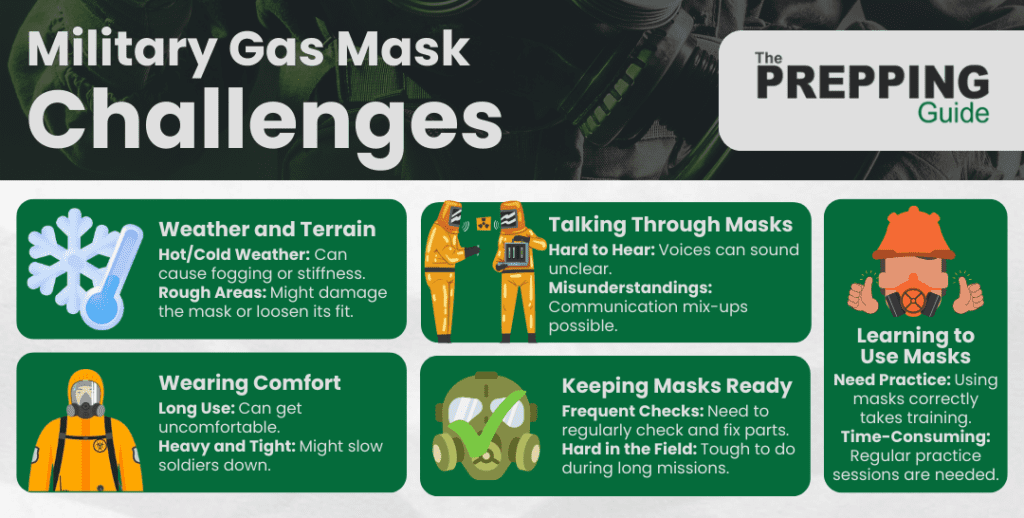
Understanding these aspects is crucial for both improvement and effective use in the field.
Physical and Environmental Limitations
One of the primary challenges is the physical and environmental limitations of gas masks. Extreme temperatures, humidity, and rough terrain can affect the mask’s performance. For instance, lenses can fog up in high humidity, reducing visibility. Similarly, extreme cold can make the mask’s materials stiff, potentially compromising the seal and comfort.
Wearability and Comfort
While the primary function of a military gas mask is protection, wearability and comfort are significant concerns. Prolonged use can lead to discomfort, fatigue, and even respiratory strain. The weight and fit of the mask, along with the resistance it creates against breathing, can affect a soldier’s endurance and performance in the field. Balancing protection with ergonomics is a continuous challenge for designers.
Communication Hindrances
Communication is vital in military operations, and gas masks can pose a significant hindrance. Although modern masks are designed with integrated communication systems, these can sometimes be less effective, leading to muffled voices and miscommunication. Ensuring clear and effective communication while wearing gas masks remains a challenge.
Maintenance and Reliability
Gas masks require regular maintenance to ensure their reliability. Filters need to be replaced, and the mask components must be regularly checked for wear and tear. This maintenance requirement can be a logistical challenge, especially in extended field operations where resources are limited.
Training and Familiarity
Proper training in the use of gas masks is essential. However, due to their infrequent use, soldiers may not be fully familiar with the masks, leading to errors in usage. Regular training and drills are necessary to ensure proficiency, but these can be resource-intensive.
To help you determine if your military gas masks are effective, here’s a checklist you can use:
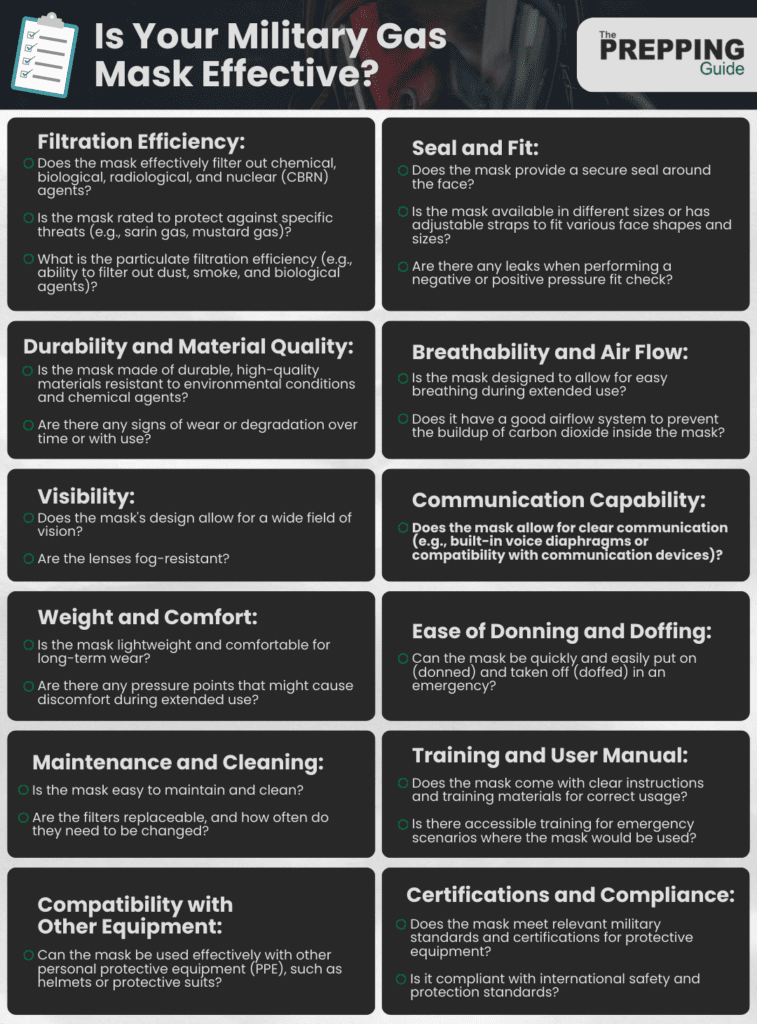
Maintenance and Lifespan
To keep your military gas mask in top-notch condition, regular cleaning is paramount. After all, it won’t do you any good if it’s dirty and compromised when you actually need it.
Start by disassembling the mask according to the manufacturer’s instructions, and clean each part thoroughly with mild soap and water. Pay extra attention to the areas that come into contact with your face, as these can accumulate sweat and grime over time.
Once cleaned, allow all the components to air dry completely before reassembling the mask. Never use harsh chemicals or solvents, as they can damage the mask’s materials and compromise its effectiveness.
Filters are another critical component of your military gas mask. They are designed to remove harmful contaminants from the air you breathe, but they have a limited lifespan.
Regularly check the expiration date on your filters, and replace them according to the manufacturer’s recommendations, even if they appear unused. Filters can degrade over time, so it’s crucial to ensure they are in good working condition.
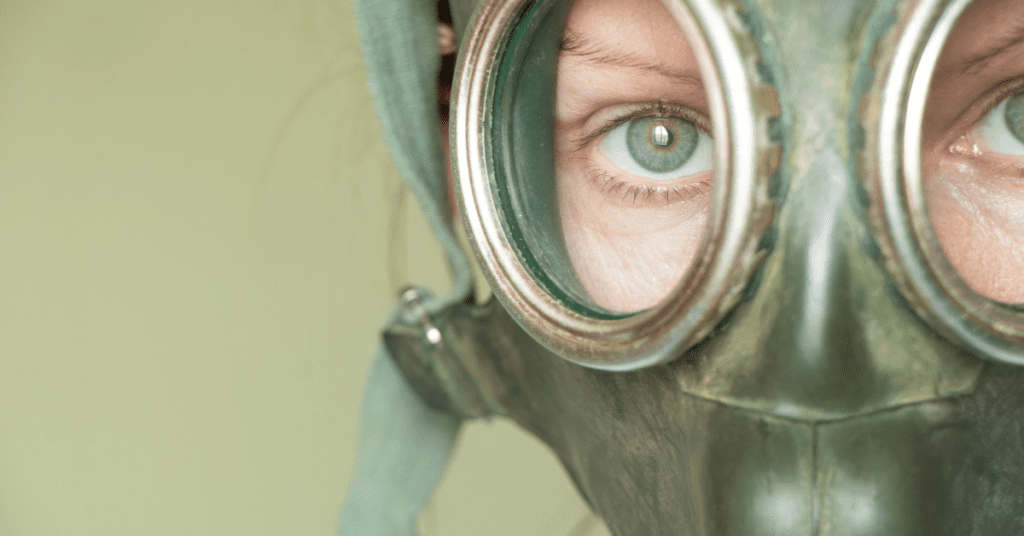
You see, military gas masks are built to last, but like all equipment, they have limitations. The lifespan of a gas mask can vary depending on factors such as the quality of materials, storage conditions, and usage frequency.
Generally, most military gas masks have a shelf life of about 10 years, but this can change depending on the specific model and manufacturer.
Proper storage is key to extending the life of your gas mask. Keep it in a cool, dry place away from direct sunlight and extreme temperatures. Avoid storing it in areas prone to moisture or high humidity, as this can lead to degradation of the mask’s components.
When Should You Use Military Gas Masks?
Military gas masks are not only used by the armed forces but also have critical applications in various civilian scenarios. Preppers, first responders, and those concerned about potential chemical, biological, radiological, or nuclear threats can benefit greatly from having a gas mask in their preparedness kit.
As the Aerospace and Defense Market Research | Fortune Business Insights said:
“In addition to their use in combat, military gas masks are also used in disaster response and homeland security operations to protect first responders and civilians from hazardous materials.”
In emergency situations, such as industrial accidents or natural disasters, where hazardous materials might be released into the environment, a gas mask can provide lifesaving protection. Additionally, military gas masks can be crucial for healthcare workers when dealing with contagious diseases or during bioterrorism events.
Having a gas mask on hand is like having an insurance policy for your respiratory health in unpredictable situations.
The Importance of Training and Fit Testing for Effective Gas Mask Use
Owning a military gas mask is one thing, but knowing how to use it effectively is another. Proper training and fit testing are essential to ensure that your gas mask will provide the protection you need when it matters most.
Training should cover how to properly don and doff the mask, how to check for a secure seal, and how to adjust straps for a comfortable yet tight fit. It’s not as simple as putting on a Halloween costume; achieving an airtight seal is critical for your safety.
Fit testing is an essential component of this training. This process ensures that the mask fits your face correctly and creates a proper seal. Fit tests are typically performed using specialized equipment that checks for any leaks. It’s recommended to undergo fit testing at least annually or whenever you replace your mask’s components.
The Future of Gas Mask Technology: Recent Innovations and Developments
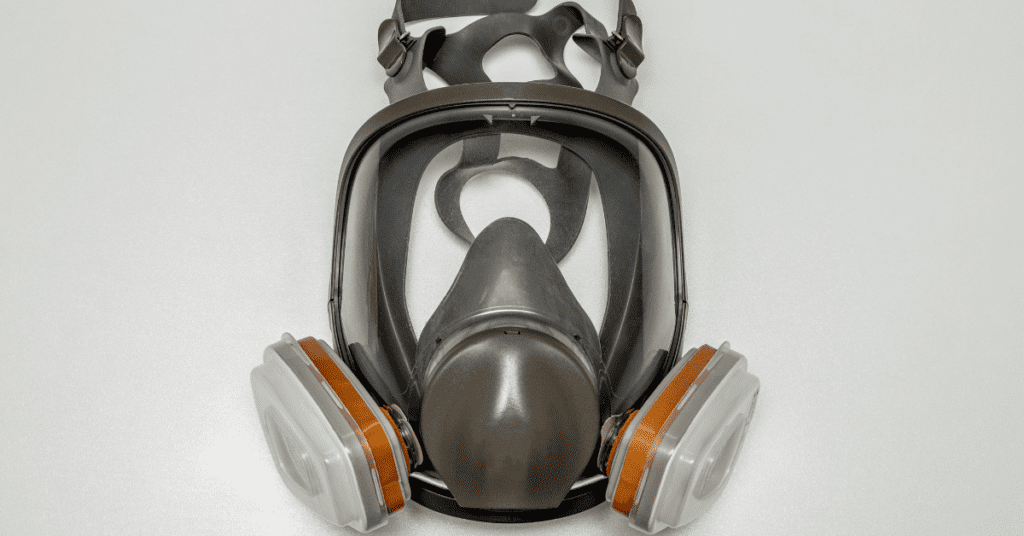
Gas mask technology is continually evolving, driven by the need for better protection and increased comfort. Recent innovations focus on enhancing user experience and ensuring optimal protection. Some developments to keep an eye on include:
- Smart Gas Masks: These masks incorporate technology to monitor air quality, provide real-time feedback, and even communicate with other devices. They can alert users to filter changes and potential threats, making them invaluable in rapidly changing environments.
- Lightweight Materials: Advancements in materials science have led to lighter, more comfortable gas masks without compromising on protection. This means you can wear them for extended periods with less discomfort.
- Improved Filters: Filters are getting more efficient at removing harmful contaminants while maintaining airflow. Some filters can even be customized for specific threats, providing tailored protection.
- Advanced Sealing Mechanisms: Manufacturers are constantly improving the sealing mechanisms of gas masks to ensure airtight fits and reduce the risk of leaks.
As technology continues to advance, we can expect even more impressive features and capabilities from future gas mask models.
Final Thoughts
As we conclude our exploration of military gas masks, it’s important to reiterate their significance in preparedness and emergency situations. These versatile pieces of equipment are not just for military personnel; they have practical applications for preppers and the general public alike.
In a world where unexpected events can occur, having the right tools and knowledge at your disposal can make all the difference. While we hope you never find yourself in a situation where you need a military gas mask, being prepared can provide peace of mind and potentially save lives. Stay safe, stay prepared, and be ready for whatever challenges may come your way.

If a person wears glasses, how do the masks seal around the temples of the glasses? I have always wondered about this problem.
Alan,
Troops using military gas masks cannot wear standard eyeglasses. Military masks have special inserts that hold corrective lenses inside of the eye ports. Troops needing glasses have to be specially examined and inserts made specifically for them. You cannot wear contacts. I never needed inserts, but my oldest daughter does and she hates them. However, given the alternatives, she tolerates them. I need glasses for reading now, but I can manage without them when wearing my current mask as part of my prep supplies.